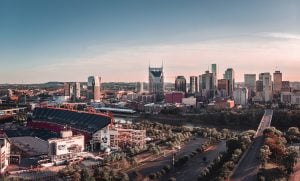Italy is full of history and beauty pretty much everywhere you look.
Which can make winnowing down where to go molto difficile when you haven’t got molti soldi: Do you live out your Roman Holiday in the Eternal City à la Audrey Hepburn, or spend your time — and euros — on hiking the colored towns of Cinque Terre? How about skipping the crowds and finding the best places to visit during the winter? Or visiting the best beaches Italy has to offer?
Luckily, you don’t actually have to pick. Thanks to Wanderu’s unique routing technology, we were able to map a tour of Italy that allows you to see everything on the country’s must-see hit list: the Colosseum, Pompeii, the Leaning Tower of Pisa and more — all for less than $130 (gelati costs, unfortunately, not included).
And a bonus: Because these prices are all just averages, there’s a good chance you can score an even better deal!
Check out a map of the full route below:
| Route | $ | € | £ |
|---|---|---|---|
| Rome to Naples | $15.87 | €14.09 | £12.68 |
| Naples to Florence | $27.36 | €24.30 | £21.86 |
| Florence to Pisa | $11.54 | €10.25 | £9.22 |
| Pisa to La Spezia (Cinque Terre) | $8.51 | €7.56 | £6.80 |
| La Spezia (Cinque Terre) to Bologna | $16.81 | €14.93 | £13.43 |
| Bologna to Venice | $10.06 | €8.93 | £8.07 |
| Venice to Turin | $25.44 | €22.59 | £20.33 |
| Turin to Milan | $11.72 | €10.41 | £9.37 |
| TOTAL TRAVEL COST: | $127.31 | €113.06 | £101.76 |
- Bus & train prices are based on the average cost of a one-way ticket for the respective route available on Wanderu over a 30-day period.
Traveling between cities by bus is the cheapest way to tour Europe, meaning you can spend your hard-earned money on other essentials (like chianti and spaghetti carbonara).
Truly, your time on the bus will fly by as pastoral Italy passes your window — and if you get bored of that, just take a nap or pre-download some movies on Netflix and voila, you’re there.
The trip starts in Italy’s cosmopolitan capital, Rome, and ends in the northern city of Milan, stopping at seven other destinations along the way. Ready your appetite and prepare to live la dolce vita. Below, find the full itinerary broken down by individual stop:
1. Rome
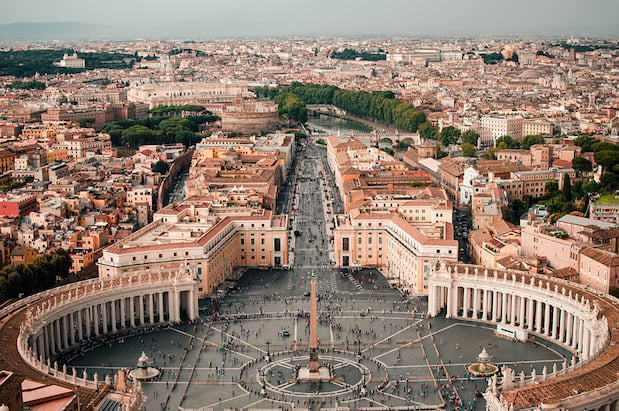
Where to start in a city with so much to offer? Book ahead to skip the line at the Vatican Museum, and get there when it opens at 9 a.m., unless you prefer your Sistine Chapel with a side of strangers-pressed-together.
There’s no way to buy skip-the-line privileges from the Vatican for St. Peter’s Basilica, unfortunately, but if you book a tour, you’ll be shuttled through a special entrance. (Pro tip: Unless you’re a Pope Francis die-hard, avoid visiting on the busiest day, Wednesday, when he makes his weekly papal address in the square.)
From the Vatican, it’s a pleasant stroll across the river to two more famous landmarks in Rome: Piazza Navona, which is one of the city’s most beautiful squares, and the Pantheon, which has an opening to the sky and houses the remains of the painter Raphael and the first king of Italy, Vittorio Emanuele II, among others.
Next, it’s off to the Colosseum, best known for its turn in the 2000 film Gladiator (we’re joking — it’s only the largest amphitheater ever built). Since it is one of the main attractions in the city, be sure to avoid common mistakes when visiting the Colosseum. Save the Spanish Steps and Trevi Fountain for nightfall, where you can sit with wine, gelato, or both.
Treat yourself to pizza al taglio at Marinella (located dangerously close to St. Peter’s), and don’t sleep on the creamy carbonara at Roscioli, which is generous with its pieces of guanciale. In terms of European capitals, Rome is among the more reasonably priced, meaning you can afford that second negroni.
To otherwise eat like a Roman, chow down standing up: order trippa alla Romana (a tripe sandwich) from Mordi e Vai at Testaccio Market, and get salted, fried cod at Dar Filettaro near Campo de Fiori. Find the best hotels in Rome to extend your trip to at least a few days if you want to see the city’s highlights!
2. Naples

Often passed over for cities of more renown, Naples is worth a stop on any Italian road trip, at least for its thin, chewy, gooey pizza alone (we’re partial to pies from Gino e Toto Sorbillo and L’antica Pizzeria da Michele Forcella).
In between bites of the stuff, stroll the city’s historic center — the largest in Europe, and a UNESCO World Heritage Site — and make sure you set aside some time to sit at any of the cafés along Via Caracciolo e Lungomare di Napoli, a seaside promenade on the Gulf of Naples with views of the island of Capri and Mount Vesuvius.
For some of the best views of Naples itself, head up (and up … and up) to Certosa e Museo di San Martino, which was founded in the 14th century as a monastery and sits high above the city on Vomero Hill. Save your legs and skip the hike: Instead, pay around €1 to take the funicular to Morghen station, which is a short walk from the site. Or, if you’re in Italy in spring, it’s the perfect season to hike up Mount Vesuvius.
For a day trip, head to nearby Pompeii, which is approximately 15 miles from downtown. The ancient city, buried by a Mount Vesuvius eruption in 79 AD but not discovered until 1748, is remarkably well-preserved, with streets, an amphitheater, and even a brothel with graffiti on prices and services.
3. Florence
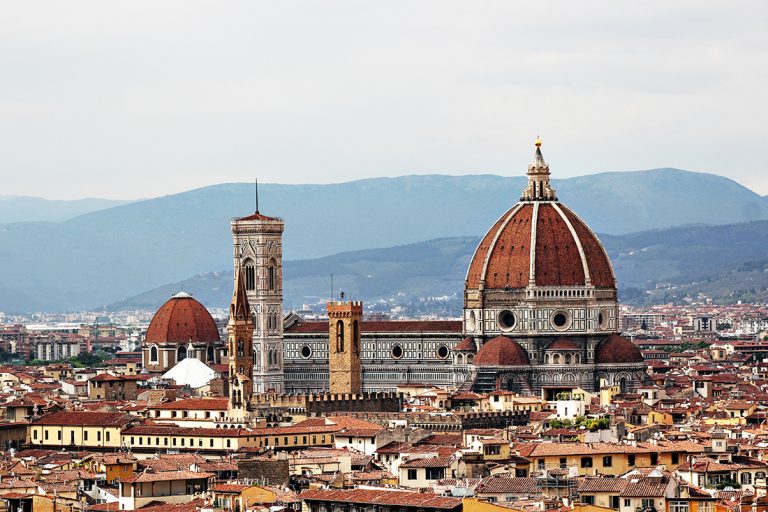
The capital of Tuscany, Florence, is a destination famous for its Renaissance art and architecture.
Make your first stop the Cathedral of Santa Maria del Fiore, better known as the Duomo. The red-tiled dome was designed by Brunelleschi, and offers one of the best views of the surrounding countryside — if you’re willing to climb the more than 400 steps it takes to get there, that is. (Note: Tickets must also be reserved online.)
Make like a Medici and check out famous works from the family’s collection at The Uffizi, the first modern museum in Europe: Botticelli’s “Birth of Venus,” Raphael’s “Madonna of the Goldfinch” and Piero della Francesca’s “Duke and Duchess of Urbino” among them.
Once done, dawdle on Ponte Vecchio, a medieval stone bridge over the Arno River known for its arches and shops selling jewelry and souvenirs.
Finally, earmark a few hours for the Mercato Centrale, a must-visit even if you only have one day in Florence. It has both an outdoor section (with things like leather goods, pottery and souvenirs) and an indoor, two-level food market with everything from handmade Mozzarella di Bufala to truffle beer.
4. Pisa
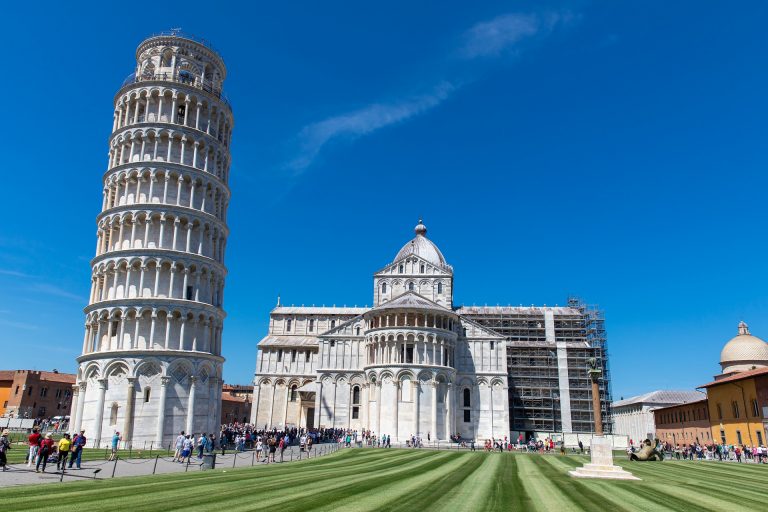
Pisa’s iconic, 14th-century leaning tower is its most famous landmark, and spending time in and around its complex — including the Cathedral and Baptistery — is well worth it.
One fan of Pisa was artist Keith Haring, who visited in 1989 and painted a colorful mural, “Tuttomondo,” on a wall of the church of Sant’Antonio at the request of the city. It was the artist’s last public work before his death in 1990.
Pisa’s city walls were built between 1155 and 1161, making them some of the oldest intact walls in Italy. As of 2017, the walls have been reopened, and visitors can walk nearly two miles over the city’s four gates.
Come sunset, head to the banks of the Arno River and sit for some sips at microbrewery La Staffetta TAP ROOM, which has a rotating number of house-produced suds on tap, as well as other beers from small local breweries to cap off your perfect day in Pisa.
5. La Spezia (Cinque Terre)
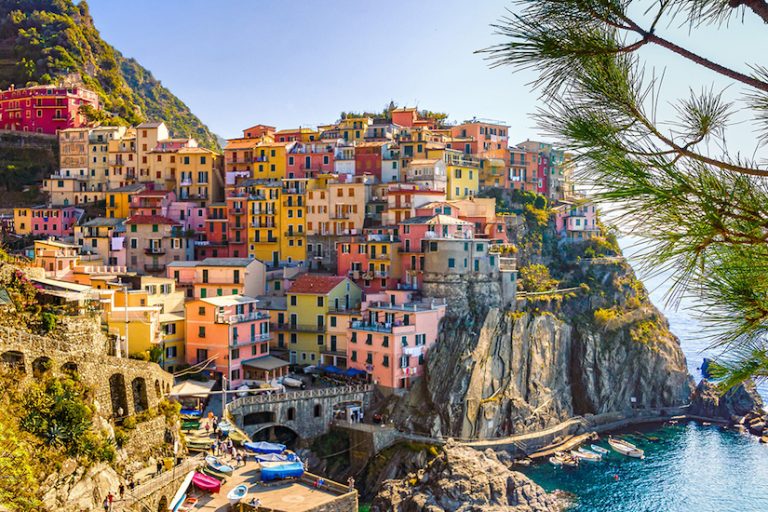
The port city of La Spezia has its charms (see: the hilltop St. George’s Castle), but mainly serves as a jumping-off point for Cinque Terre, those five picturesque seaside villages you’ve probably seen here, there, and well, everywhere.
The colorful towns are as postcard-perfect in real life, though each is slightly different. Plan the perfect Cinque Terre itinerary with some or all of these stops!
Riomaggiore
The first stop north from La Spezia is Riomaggiore, often considered one of the quietest of the five, and known for its slate-roof-topped stone houses, which are built into the rock by the water.
Manarola
Next up is Manarola, which has a picturesque harbor flanked by seafood restaurants, and is home to the start of the Via dell’Amore — or Lover’s Lane — trail.
Corniglia
The middle town, Corniglia, is the only one of the five not built directly on the water: Instead, it’s some 330 feet above sea level, and as a result is the least-visited by tourists along this stretch. (It can be accessed by hiking or a train connection.) Surrounded by vineyards, it feels more like a tucked-away inland town than a coastal one.
Vernazza
Vernazza, because of its amphitheater-shaped pier, is probably the most photographed of the five villages. Its hilltop medieval castle was built in the mid-1500s to protect the town from pirates. None linger around these parts today, but you can keep lookout via a perch at restaurant Belforte, inside the castle’s watchtower.
Monterosso
Monterosso, the northernmost town from La Spezia, is also the biggest of the five and has the most amenities including a long, sandy beach with umbrellas, chairs, and kayaks for rent.
The intrepid can access the towns by foot (there is a well-connected, if popular, path), but there is also an affordable train service and boats that will bring you from town to town, with the exception of Corniglia.
6. Bologna
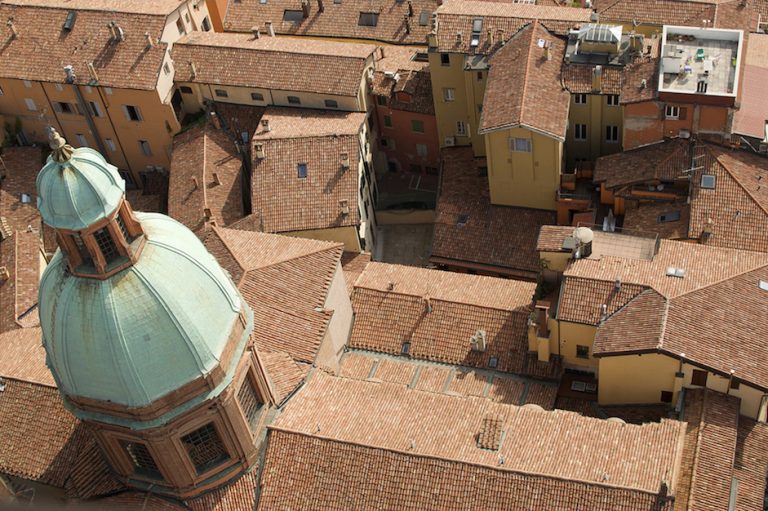
Bologna, the capital of Emilia-Romagna, is known as “La dotta, La rossa e La grassa,” a nod to the city’s notable university (la dotta), the red-hued color of its buildings (la rossa), and its rich, fatty foods (la grassa).
For history and architecture, it’s hard to top the sprawling Piazza Maggiore, Gothic Basilica di San Petronio, and 16th-century bronze Fountain of Neptune. The latter is Bologna’s most famous landmark, in large part because of its all-but-religious nature: Though commissioned by the church in the 16th century, it was panned as “too sexy” due to some of sculptor Giambologna’s artistic touches, including sea nymphs squeezing water out of their breasts. 👀
For an afternoon, enroll in gelato-making classes at Carpigiani Gelato University (yes, really) and eat (and eat again) on Via del Pratello: Try Pasta Fresca for its takeaway tagliatelle with ragu, and Piadina Pratello for its to-go piadina — Italian flatbreads typical of the region, stuffed with things like prosciutto and mozzarella.
7. Venice
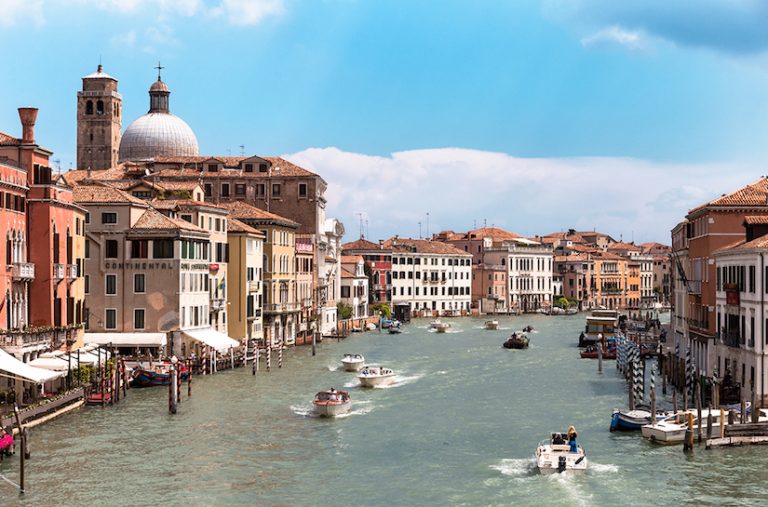
Though St. Mark’s Square and Basilica are where the crowds concentrate, it’s worth remembering that Venice comprises more than 100 small islands ripe for exploration.
Once you’ve snapped a photo (or five) on the ornate Rialto Footbridge, taken a tour of the Grand Canal via boat and walked Doge’s Palace, try breaking out of the city center to visit some of them.
Among the closest ones is the once-independent commune of Murano, a collection of seven islands connected by bridges where all of the glassmakers in Venice were forced to move in the 13th century because of the risk of fires.
The area is therefore known for its glass-work, including chandeliers, beads, mirrors and wine-stoppers. It even has a museum — Museo del Vetro — dedicated to the craft.
Even further off the beaten path, Burano is known for its colorful fisherman’s houses and seafood eateries, which serve fresh fish from the lagoon. The island is also popular for lace-making, a tradition that began on the island in the 16th century and continues to this day. There is no shortage of incredible things to see on your Venice itinerary.
8. Turin
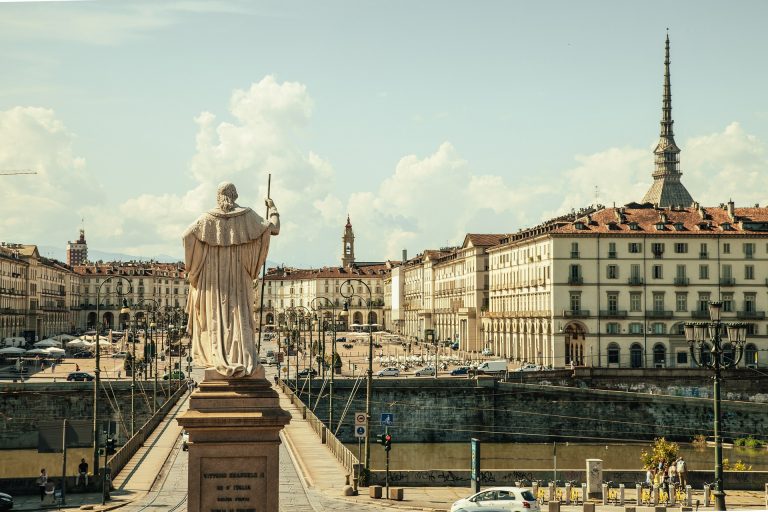
Backed by the Alps to the northwest, Turin is known for its grand boulevards and mix of Renaissance, Baroque, Rococo, Neoclassical and Art Nouveau architectural styles.
One of its most famous attractions is the Shroud of Turin, a piece of linen with the negative image of a man many believe to be Jesus. Evidence points to it being a forgery, but nevermind: The Chapel of the Holy Shroud, located in the Turin Cathedral, still draws visits from the faithful. 🙏
Once a capital of European filmmaking, Turin today has a museum dedicated to the city’s history with moving pictures. You can find the Museo Nazionale del Cinema inside the Mole Antonelliana tower, itself a landmark for its design (it’s thought to be the tallest museum in the world).
Chocolate-lovers will find paradise in Turin thanks to the city’s sweet history. It was here that hot chocolate, chocolate candy, and the combination of chocolate and hazelnuts were all invented. Pick up a few chocolate bars at mainstay Peyrano, which was founded in 1915, or sit at the ornate Caffè Mulassano for a bicerin — made of espresso, hot chocolate and whipped cream.
9. Milan
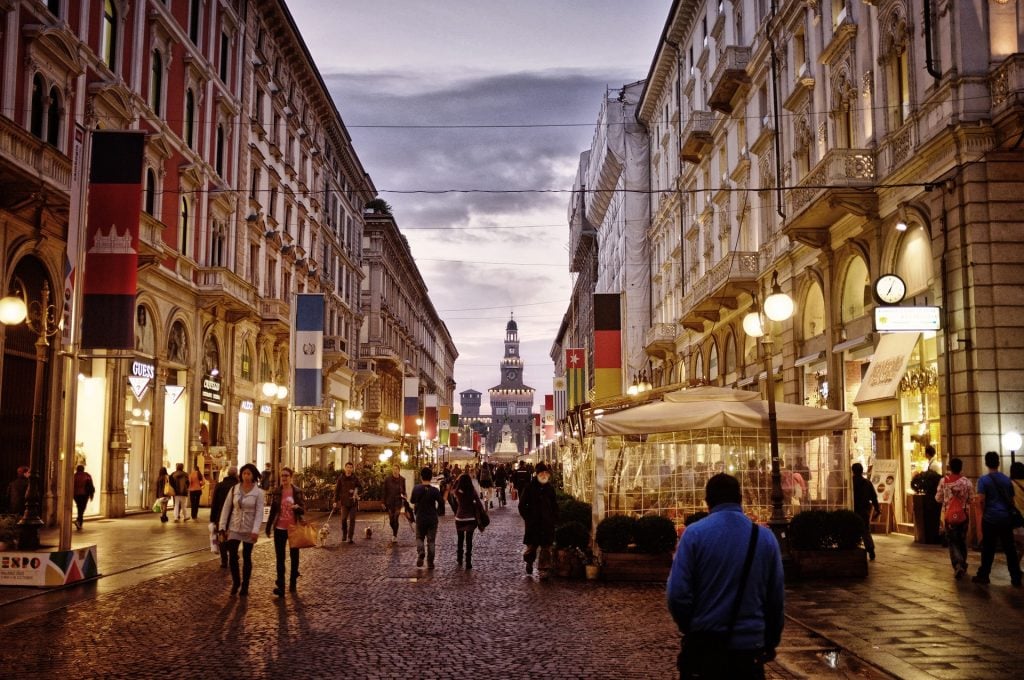
Milan is undoubtedly Italy’s cosmopolitan capital, home to labels like Valentino, Versace, Armani, and Dolce & Gabbana as well as hidden gems to discover in Milan during your stay.
Even if you can’t afford springing for, say, a €750 pair of shoes, Galleria Vittorio Emanuele II is worth a visit: As Italy’s oldest shopping mall, it’s topped with a glass dome and has a triumphal arch leading to an ornate interior.
Look, too, for the torino mosaic on the floor: Legend has it that if you plant your heel and spin three times on a particular, um, part of the bull (🥜), you’ll receive good luck.
Conveniently, the Galleria connects two of Milan’s other most important landmarks: Teatro Alla Scala, one of the world’s best opera houses, and the Duomo, a cathedral that took six centuries to complete and today is the largest church in Italy. (St. Peter’s, though larger, is in the Vatican, which is technically its own city-state.)
Fashion and architecture aside, perhaps no city in Italy does aperitivo better than Milan. 🥂
The Italian tradition of a pre-dinner drink and several appetizers is a ritual here, and around 6 p.m., bars and cafés begin filling up with patrons prepping for their nighttime meal. Cantine Isola, which opened in 1896 as a wine bar, is superb, as is Il Salumaio di Montenapoleone, located within the open-air interior courtyard of Museo Bagatti Valsecchi.
Saluti!
How We Did It
In terms of bucket-list attractions, Italy truly is an embarrassment of riches.
From the Colosseum to the charming canals of Venice, you’ll wrap this trip having experienced all the most epic sites in Italia for less than the price of a venti latte at Starbucks. (OK, more like 30 venti lattes. But you get the point.)
And remember: Because the prices listed are all just averages, it’s very possible you’ll get an even better deal — which means more money in your pocket.
To experience Italy’s greatest hits for yourself, head straight to Wanderu.com or download the Wanderu app — the best way to book cheap bus and train tickets all across Europe. And if you thought Italy was cheap, try our tour of Holland, where you can hit eight cities for less than $100.
Using Wanderu’s proprietary data on bus travel in Italy — including pricing, duration and schedule information from multiple bus carriers — we leverage our unique routing technology to map and build multi-stop travel itineraries using trips from various providers in real time. By measuring each leg for the best balance of price and duration, we were able to find the most optimal road trip around Italy.
The prices quoted in this article are based on the average cost of bus tickets available on Wanderu for each route over a 30-day period.
To ensure that this trip is more than just data science, the Wanderu algorithm used actual bookable trips to verify that this road trip was possible at these prices over multiple consecutive days.








